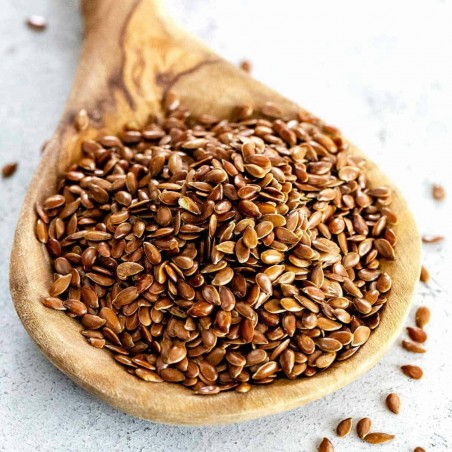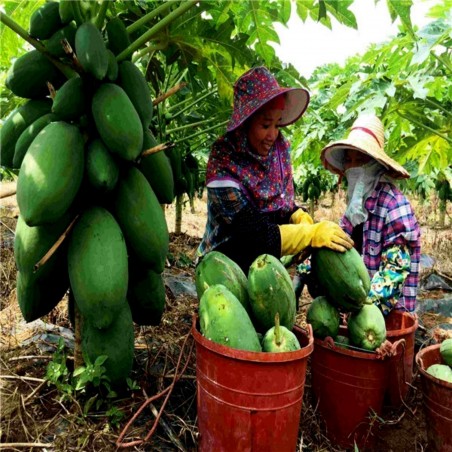
Spice Flax medicinal and healthy
Flax medicinal and healthy
The price is for packaging of 10 grams of this spice.
Flax (Linum usitatissimum), also known as common flax or linseed, is a member of the genus Linum in the family Linaceae. It is a food and fiber crop cultivated in cooler regions of the world. The textiles made from flax are known in the Western countries
Flax medicinal and healthy
The price is for packaging of 10 grams of this spice.
Flax (Linum usitatissimum), also known as common flax or linseed, is a member of the genus Linum in the family Linaceae. It is a food and fiber crop cultivated in cooler regions of the world. The textiles made from flax are known in the Western countries as linen, and traditionally used for bed sheets, underclothes, and table linen. The oil is known as linseed oil. In addition to referring to the plant itself, the word "flax" may refer to the unspun fibers of the flax plant. The plant species is known only as a cultivated plant, and appears to have been domesticated just once from the wild species Linum bienne, called pale flax.
Several other species in the genus Linum are similar in appearance to L. usitatissimum, cultivated flax, including some that have similar blue flowers, and others with white, yellow, or red flowers. Some of these are perennial plants, unlike L. usitatissimum, which is an annual plant.
Cultivated flax plants grow to 1.2 m (3 ft 11 in) tall, with slender stems. The leaves are glaucous green, slender lanceolate, 20–40 mm long, and 3 mm broad.
The flowers are pure pale blue, 15–25 mm in diameter, with five petals. The fruit is a round, dry capsule 5–9 mm in diameter, containing several glossy brown seeds shaped like an apple pip, 4–7 mm long.
Flax is grown for its seeds, which can be ground into a meal or turned into linseed oil, a product used as a nutritional supplement and as an ingredient in many wood-finishing products. Flax is also grown as an ornamental plant in gardens. Moreover, flax fibers are used to make linen. The Latin name of the species, usitatissimum, means "most useful".
Flax fibers taken from the stem of the plant are two to three times as strong as cotton fibers. Additionally, flax fibers are naturally smooth and straight. Europe and North America both depended on flax for plant-based cloth until the 19th century, when cotton overtook flax as the most common plant for making rag-based paper. Flax is grown on the Canadian prairies for linseed oil, which is used as a drying oil in paints and varnishes and in products such as linoleumand printing inks.
Linseed meal, the byproduct of producing linseed oil from flax seeds, is used to feed livestock. It is a protein-rich feed for ruminants, rabbits, and fish.
A 100-gram portion of ground flaxseed supplies about 534 calories (2,230 kJ), 41 g of fat, 28 g of fiber, and 20 g of protein.
Flaxseed sprouts are edible and have a slightly spicy flavor profile. Excessive consumption of flaxseeds with inadequate amounts of water may cause bowel obstruction. In northern India, flaxseed, called tisi or alsi, is traditionally roasted, powdered, and eaten with boiled rice, a little water, and a little salt. In India, linseed oil is known as alsi in Hindi and javas in Marathi. It is mainly used in Savji curries, such as mutton (goat meat) curries.
Whole flaxseeds are chemically stable, but ground flaxseed meal, because of oxidation, may go rancid when left exposed to air at room temperature in as little as one week. Refrigeration and storage in sealed containers will keep ground flaxseed meal for a longer period before it turns rancid. Under conditions similar to those found in commercial bakeries, trained sensory panelists could not detect differences between bread made with freshly ground flaxseed and bread made with flaxseed that had been milled four months earlier and stored at room temperature. This shows, if packed immediately without exposure to air and light, milled flaxseed is stable against excessive oxidation when stored for nine months at room temperature, and under warehouse conditions, for 20 months at ambient temperatures.
Three natural phenolic glucosides—secoisolariciresinol diglucoside, p-coumaric acid glucoside, and ferulic acid glucoside—can be found in commercial breads containing flaxseed.
Flax fiber is extracted from the bast beneath the surface of the stem of the flax plant. Flax fiber is soft, lustrous, and flexible; bundles of fiber have the appearance of blonde hair, hence the description "flaxen" hair. It is stronger than cotton fiber, but less elastic. The best grades are used for fabrics such as damasks, lace, and sheeting. Coarser grades are used for the manufacturing of twine and rope, and historically, for canvas and webbing equipment. Flax fiber is a raw material used in the high-quality paper industry for the use of printed banknotes, laboratory paper (blotting and filter), rolling paper for cigarettes, and tea bags.
The use of flax fibers dates back tens of thousands of years; linen, a refined textile made from flax fibers, was worn widely by Sumerian priests more than 4,000 years ago. Industrial-scale flax fiber processing existed in antiquity. A Bronze Age factory dedicated to flax processing was discovered in Euonymeia.
Flax mills for spinning flaxen yarn were invented by John Kendrew and Thomas Porthouse of Darlington, England, in 1787. New methods of processing flax have led to renewed interest in the use of flax as an industrial fiber.
One study of research published between 1990 and 2008 showed that consuming flaxseed or its derivatives may reduce total and LDL-cholesterol in the blood, with greater benefits in women and those with high cholesterol.
A meta-analysis has shown that consumption of more than 30 g of flaxseed daily for more than 12 weeks reduced body weight, body mass index (BMI), and waist circumference for persons with a BMI greater than 27. Another meta-analysis has shown that consumption of flaxseed for more than 12 weeks produced small reductions in systolic blood pressureand diastolic blood pressure Flaxseed supplementation showed a small reduction in c-reactive protein (a marker of inflammation) only in persons with a BMI greater than 30.

Vaše hodnocení nelze odeslat
Nahlásit komentář
Zpráva odeslána
Váš podnět nelze odeslat
Napište svůj názor
Zkontrolovat před odesláním
Vaši recenzi nelze odeslat
🌍 Globální doručení z EU
Zásilky odesíláme do celého světa z Evropské unie prostřednictvím registrované pošty s potvrzením o doručení.
📦 Sledování zásilky
Pro sledování zásilky se přihlaste ke svému účtu a přejděte do sekce Historie objednávek > Detail, kde najdete sledovací číslo.
Mezinárodní sledování: 17Track
Pro čísla jako RGxxxxxxHR: Posta.hr sledování
🕒 Informace o sledování jsou dostupné až 24 hodin po odeslání zásilky.
⚠️ Důležité upozornění
Dobírka není možná.
Pravidelně kontrolujte složku spam / nevyžádaná pošta ve své e-mailové schránce.
Používejte pouze kontaktní formulář na našich stránkách.
E-maily zaslané přímo na naši adresu nemusí být přijaty.
📱 Povinné telefonní číslo
Při objednávce uveďte své mobilní číslo s předvolbou země.
Příklad: +420 123 456 789
🚚 Podmínky doručení
Registrované zásilky vyžadují podpis příjemce.
Neobjednávejte, pokud:
chcete doručení do poštovní schránky
nebudete doma k převzetí zásilky
chcete, aby balík byl doručen sousedovi (❌ není možné)
📬 Pokud zadáte adresu poštovní schránky a zásilka bude ztracena, nemáte nárok na vrácení peněz.
↩️ Vrácení zásilky a opětovné odeslání
Pokud je zásilka z jakéhokoliv důvodu vrácena zpět k nám:
Budete hradit náklady na zpětné zaslání 2 €
A také náklady na opětovné odeslání
⏱ Zpoždění a sledování
Pokud sledování ukazuje, že zásilka je stále u odesílatele, znamená to, že je na cestě.
Kontaktujte místní poštu s číslem sledování pro aktuální informace.
Nejsme poštovní službou a zásilku za vás nesledujeme.
Nezodpovídáme za dobu doručení.
🔍 Vyšetřování ztráty zásilky lze zahájit až 30 dní po odeslání.
✈️ Možnosti dopravy
| Typ dopravy | Doba zpracování | Pojištění | Možné zpoždění | Poznámka |
|---|---|---|---|---|
| Standardní | 7–10 pracovních dnů | ❌ | 7–14 pracovních dnů | Nejlevnější možnost |
| Prioritní | 1–7 pracovních dnů | ❌ | 3–10 pracovních dnů | Prioritní zpracování – ne nutně rychlejší doručení |
| Pojištěná | 1–7 pracovních dnů | ✅ | 3–10 pracovních dnů | Vrácení peněz při ztrátě (do 150 €) |
🕒 Odhadovaná doba doručení:
V rámci EU: 3–20 pracovních dnů
Celosvětově: 5–30 pracovních dnů
Příklady doby doručení do USA: 27, 22, 19, 17, 13 dnů
💳 Platební metody
💶 Bankovní převod (SEPA / IBAN / SWIFT-BIC)
Uveďte číslo objednávky v platebním příkazu (např. SGS-19811702).
Chybějící reference může způsobit zpoždění nebo zrušení objednávky.
Pokud platba nedorazí do 7 dnů, objednávka bude automaticky zrušena.
🅿️ PayPal
Přijímáme platby pouze v eurech.
Nastavte měnu na euro při platbě.
💳 Platba kartou
Platby kartou probíhají přes náš web: Exotic Seeds Store
Akceptujeme Visa, MasterCard, American Express, Diners Club, UnionPay, JCB, Discover a další.
💡 Zákazník hradí všechny transakční poplatky.
Pro rychlejší vyřízení objednávky pošlete potvrzení o platbě.
📅 Další informace
Objednávky nevyřizujeme a neodesíláme o víkendech (sobota a neděle).
Před objednáním si vždy přečtěte důležitá oznámení na našem webu (svátky, speciální podmínky atd.).
📫 Pozor:
Neposílejte nám zprávy přímo na e-mail. Používejte pouze kontaktní formulář na našem webu.
Related Products









